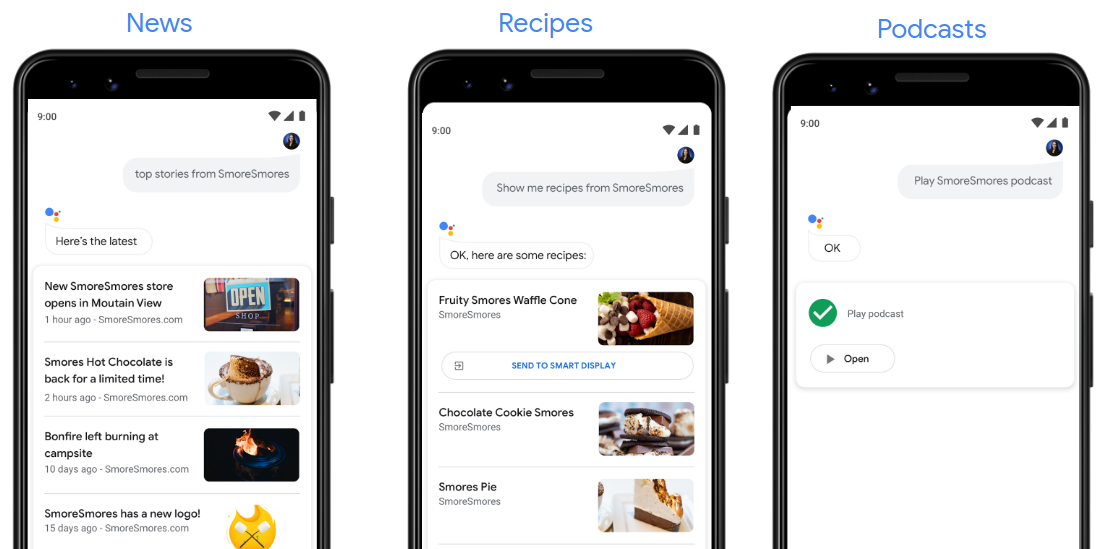تُطلع البيانات المنظَّمة محرّك بحث Google على نوع المحتوى الذي تنشئه، وبالتالي يمكننا عرضه للمستخدمين بطريقة تفاعلية. بالإضافة إلى عرض المحتوى الخاص بك كنتيجة غنية بصريًا على "بحث Google"، يمكننا قراءة الترميز لإنشاء مهمة تلقائيًا تعرض المحتوى الخاص بك على "مساعد Google" وإنشاء إدخال في دليل "مساعد Google". عندما يطلب المستخدمون من "مساعد Google" تقديم أحد أنواع المحتوى المتاحة، قد نعرض الإجراء الخاص بك.
وإذا كنت لا تزال مبتدئًا في هذا المجال، يمكنك التعرّف على المزيد من المعلومات حول آلية عمل البيانات المنظَّمة.

نشر المحتوى
يمكن أن تنشئ Google مجموعة متنوعة من الإجراءات استنادًا إلى محتوى الويب الذي تقدّمه. يُرجى الرجوع إلى القائمة التالية لأنواع المحتوى المتوافقة للاطّلاع على كيفية إنشاء إجراءات لكل نوع:
| الأسئلة الشائعة | إنّ المستخدمين الذين يطلبون من "مساعد Google" معلومات عن موضوع معيّن يمكنهم تلقّي محتوى الأسئلة الشائعة من أجل تقديم أفضل الإجابات لهم. يمكنك إنشاء ترميز لمحتوى الأسئلة الشائعة يمكننا إنشاء إجراء تلقائيًا باستخدام معلوماتك. للحصول على معلومات حول إجراءات الأسئلة الشائعة المستندة إلى الترميز، يمكنك الاطّلاع على مستندات إجراءات الأسئلة الشائعة. |
| الوسائط | يمكن للمستخدمين اكتشاف المحتوى الخاص بك على "بحث Google" و"مساعد Google" وبدء تشغيل المحتوى مباشرةً على تطبيقك أو منصتك. للحصول على معلومات حول إعداد محتوى الوسائط، يمكنك الاطّلاع على مستندات الإجراءات على الوسائط. |
| الأخبار | ويمكن للمستخدمين مشاهدة المحتوى الخاص بك من خلال "مساعد Google" كجزء من "أخبار Google"، بما في ذلك لوحة العرض الدوّارة لأهم الأخبار. وعندما تضيف بيانات منظَّمة إلى صفحات AMP الخاصة بك، يمكننا عرض المحتوى الإخباري الخاص بك على "مساعد Google". للحصول على معلومات حول إعداد محتوى المقالة الإخبارية، يمكنك الاطّلاع على مستندات البيانات المنظَّمة الخاصة بالمقالات. |
| ملفات البودكاست |
يمكن للمستخدمين العثور على البودكاست الخاص بك في دليل "مساعد Google" وتشغيل الحلقات على أجهزتهم باستخدام "مساعد Google". يمكنك إنشاء خلاصة RSS للبودكاست، ويمكننا إنشاء مهمة له تلقائيًا. لمزيد من المعلومات حول إعداد خلاصة البودكاست، يمكنك الاطّلاع على مستندات ملفات البودكاست. |

